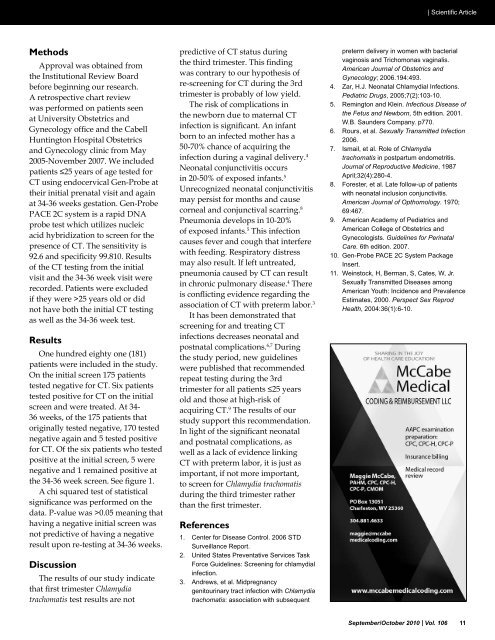September/October - West Virginia State Medical Association
September/October - West Virginia State Medical Association
September/October - West Virginia State Medical Association
Create successful ePaper yourself
Turn your PDF publications into a flip-book with our unique Google optimized e-Paper software.
| Scientific Article<br />
Methods<br />
Approval was obtained from<br />
the Institutional Review Board<br />
before beginning our research.<br />
A retrospective chart review<br />
was performed on patients seen<br />
at University Obstetrics and<br />
Gynecology office and the Cabell<br />
Huntington Hospital Obstetrics<br />
and Gynecology clinic from May<br />
2005-November 2007. We included<br />
patients ≤25 years of age tested for<br />
CT using endocervical Gen-Probe at<br />
their initial prenatal visit and again<br />
at 34-36 weeks gestation. Gen-Probe<br />
PACE 2C system is a rapid DNA<br />
probe test which utilizes nucleic<br />
acid hybridization to screen for the<br />
presence of CT. The sensitivity is<br />
92.6 and specificity 99.810. Results<br />
of the CT testing from the initial<br />
visit and the 34-36 week visit were<br />
recorded. Patients were excluded<br />
if they were >25 years old or did<br />
not have both the initial CT testing<br />
as well as the 34-36 week test.<br />
Results<br />
One hundred eighty one (181)<br />
patients were included in the study.<br />
On the initial screen 175 patients<br />
tested negative for CT. Six patients<br />
tested positive for CT on the initial<br />
screen and were treated. At 34-<br />
36 weeks, of the 175 patients that<br />
originally tested negative, 170 tested<br />
negative again and 5 tested positive<br />
for CT. Of the six patients who tested<br />
positive at the initial screen, 5 were<br />
negative and 1 remained positive at<br />
the 34-36 week screen. See figure 1.<br />
A chi squared test of statistical<br />
significance was performed on the<br />
data. P-value was >0.05 meaning that<br />
having a negative initial screen was<br />
not predictive of having a negative<br />
result upon re-testing at 34-36 weeks.<br />
Discussion<br />
The results of our study indicate<br />
that first trimester Chlamydia<br />
trachomatis test results are not<br />
predictive of CT status during<br />
the third trimester. This finding<br />
was contrary to our hypothesis of<br />
re‐screening for CT during the 3rd<br />
trimester is probably of low yield.<br />
The risk of complications in<br />
the newborn due to maternal CT<br />
infection is significant. An infant<br />
born to an infected mother has a<br />
50-70% chance of acquiring the<br />
infection during a vaginal delivery. 4<br />
Neonatal conjunctivitis occurs<br />
in 20-50% of exposed infants. 5<br />
Unrecognized neonatal conjunctivitis<br />
may persist for months and cause<br />
corneal and conjunctival scarring. 8<br />
Pneumonia develops in 10-20%<br />
of exposed infants. 5 This infection<br />
causes fever and cough that interfere<br />
with feeding. Respiratory distress<br />
may also result. If left untreated,<br />
pneumonia caused by CT can result<br />
in chronic pulmonary disease. 4 There<br />
is conflicting evidence regarding the<br />
association of CT with preterm labor. 3<br />
It has been demonstrated that<br />
screening for and treating CT<br />
infections decreases neonatal and<br />
postnatal complications. 6,7 During<br />
the study period, new guidelines<br />
were published that recommended<br />
repeat testing during the 3rd<br />
trimester for all patients ≤25 years<br />
old and those at high-risk of<br />
acquiring CT. 9 The results of our<br />
study support this recommendation.<br />
In light of the significant neonatal<br />
and postnatal complications, as<br />
well as a lack of evidence linking<br />
CT with preterm labor, it is just as<br />
important, if not more important,<br />
to screen for Chlamydia trachomatis<br />
during the third trimester rather<br />
than the first trimester.<br />
References<br />
1. Center for Disease Control. 2006 STD<br />
Surveillance Report.<br />
2. United <strong>State</strong>s Preventative Services Task<br />
Force Guidelines: Screening for chlamydial<br />
infection.<br />
3. Andrews, et al. Midpregnancy<br />
genitourinary tract infection with Chlamydia<br />
trachomatis: association with subsequent<br />
preterm delivery in women with bacterial<br />
vaginosis and Trichomonas vaginalis.<br />
American Journal of Obstetrics and<br />
Gynecology; 2006.194:493.<br />
4. Zar, H.J. Neonatal Chlamydial Infections.<br />
Pediatric Drugs, 2005;7(2):103-10.<br />
5. Remington and Klein. Infectious Disease of<br />
the Fetus and Newborn, 5th edition. 2001.<br />
W.B. Saunders Company. p770.<br />
6. Rours, et al. Sexually Transmitted Infection<br />
2006.<br />
7. Ismail, et al. Role of Chlamydia<br />
trachomatis in postpartum endometritis.<br />
Journal of Reproductive Medicine, 1987<br />
April;32(4):280-4.<br />
8. Forester, et al. Late follow-up of patients<br />
with neonatal inclusion conjunctivitis.<br />
American Journal of Opthomology. 1970;<br />
69:467.<br />
9. American Academy of Pediatrics and<br />
American College of Obstetrics and<br />
Gynecologists. Guidelines for Perinatal<br />
Care. 6th edition. 2007.<br />
10. Gen-Probe PACE 2C System Package<br />
Insert.<br />
11. Weinstock, H, Berman, S, Cates, W, Jr.<br />
Sexually Transmitted Diseases among<br />
American Youth: Incidence and Prevalence<br />
Estimates, 2000. Perspect Sex Reprod<br />
Health, 2004:36(1):6-10.<br />
<strong>September</strong>/<strong>October</strong> 2010 | Vol. 106 11















